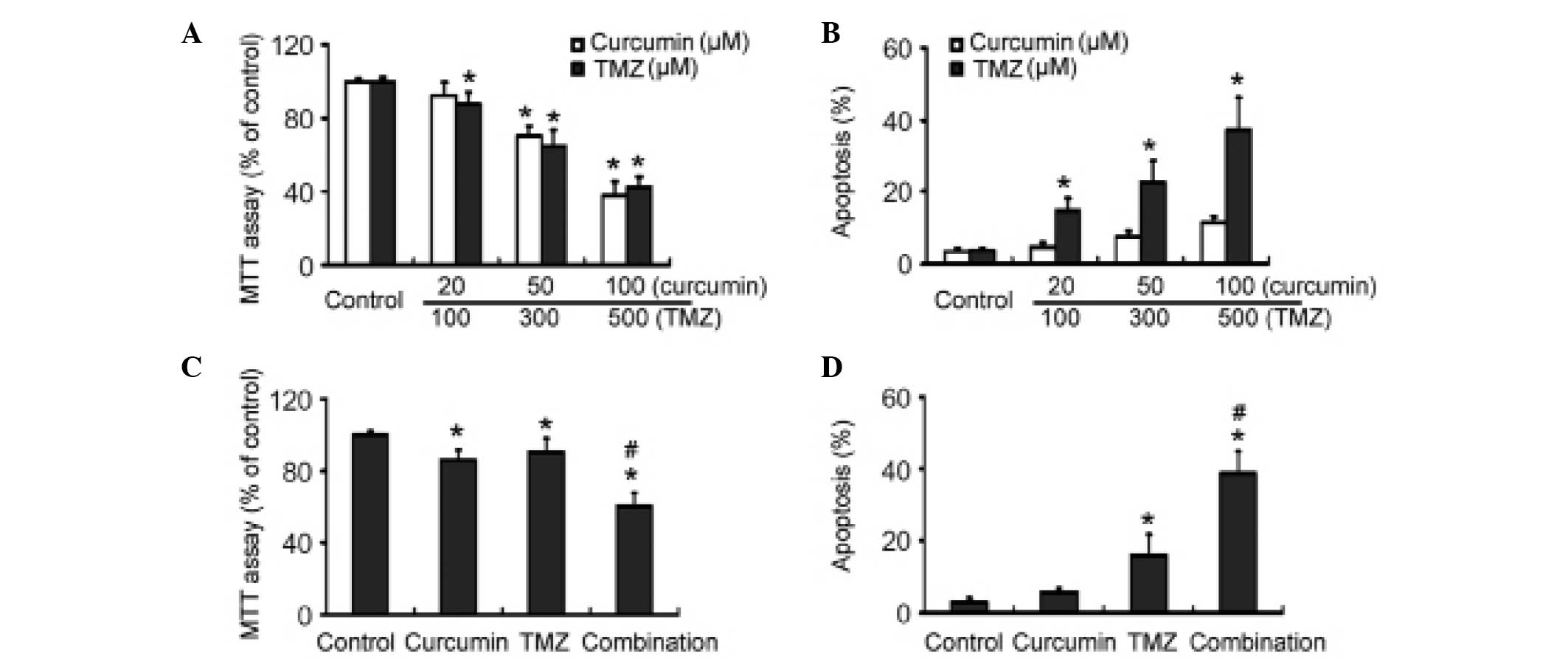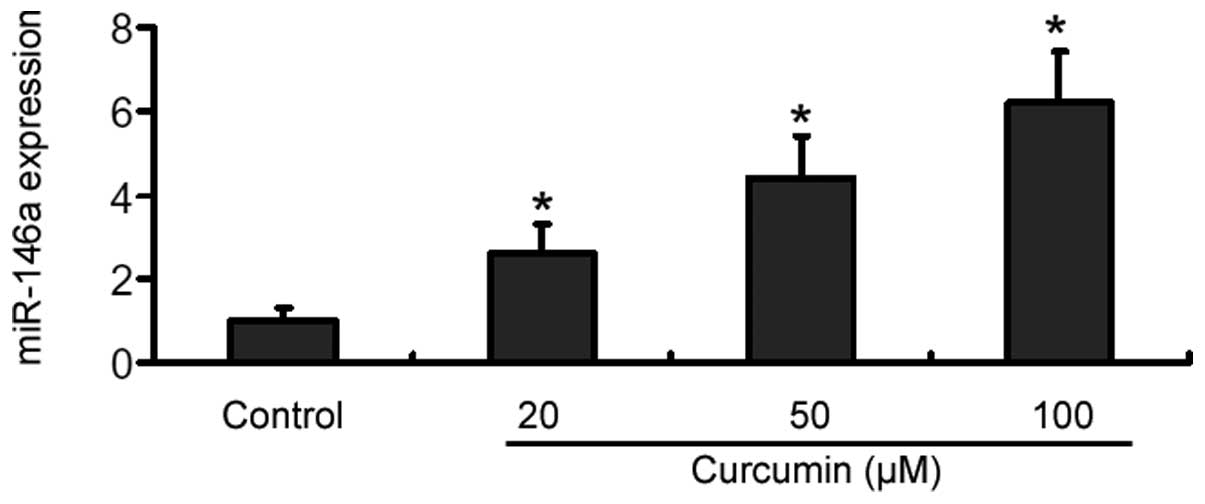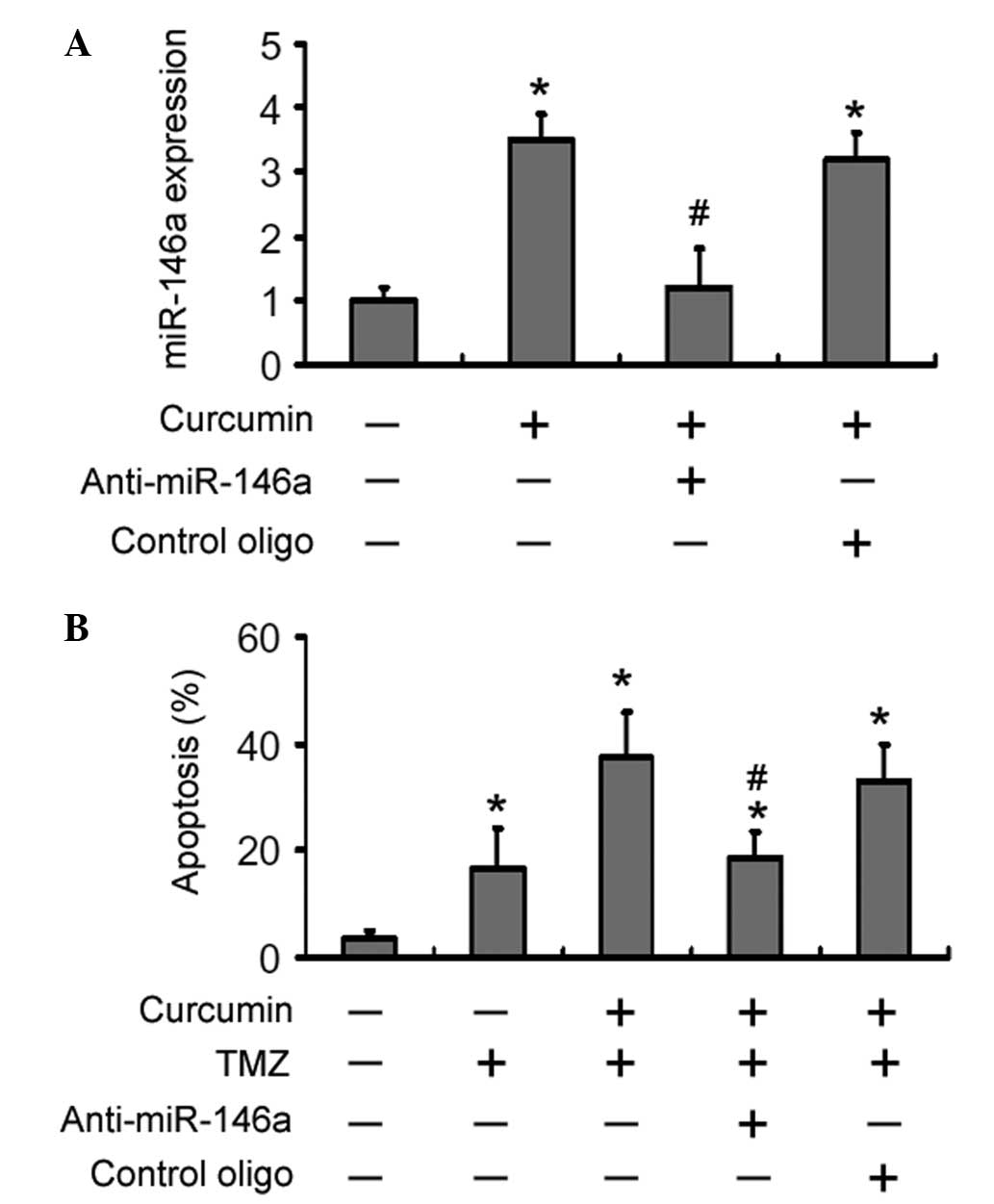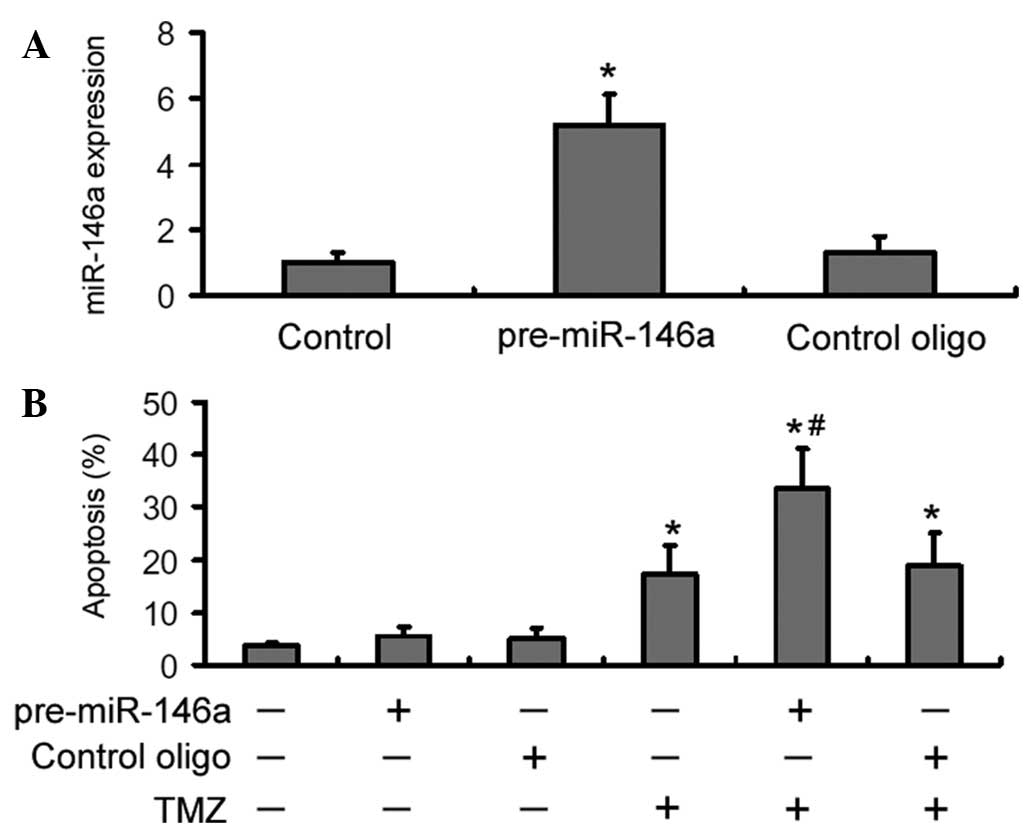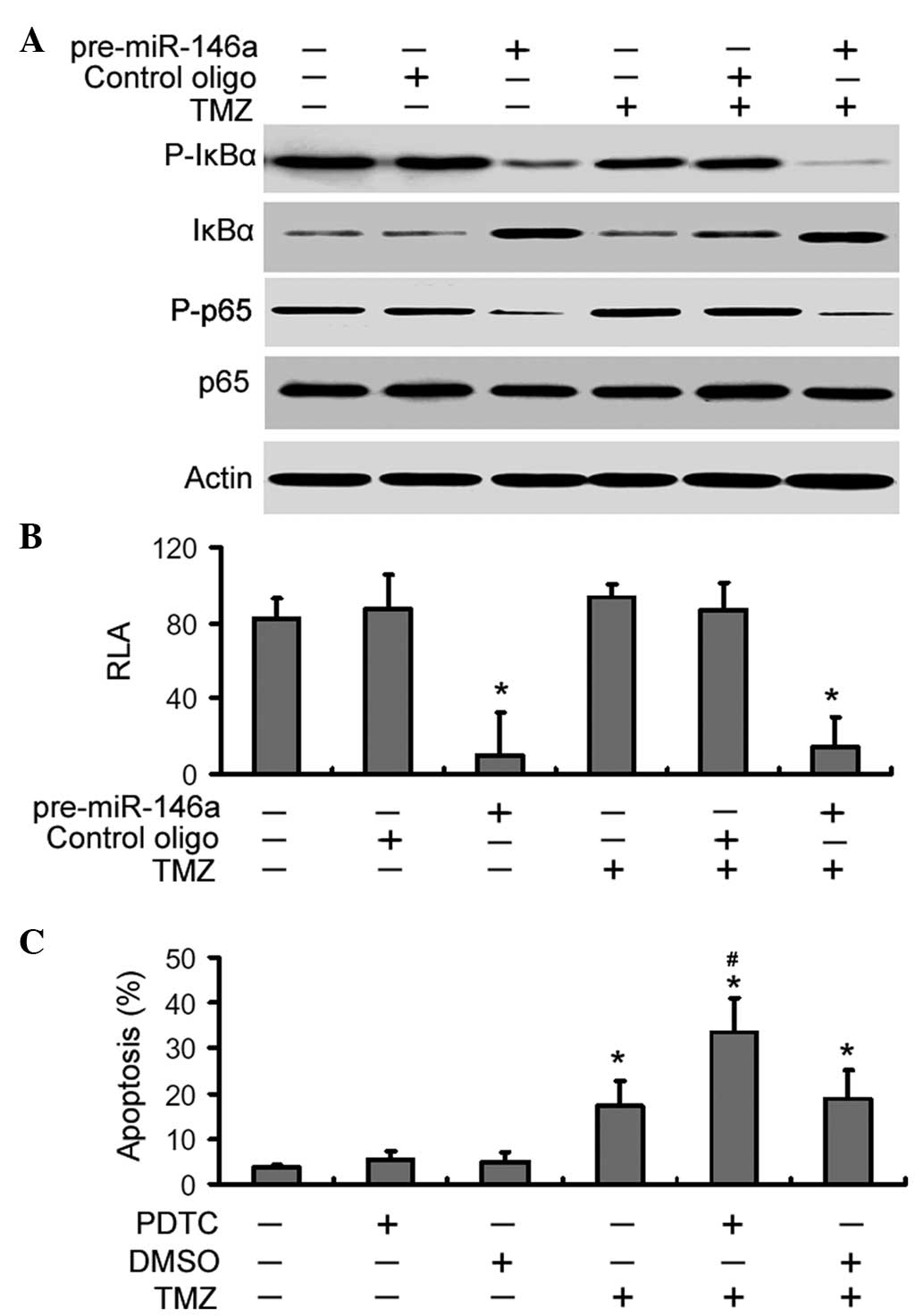Induction of microRNA-146a is involved in curcumin-mediated enhancement of temozolomide cytotoxicity against human glioblastoma
- Authors:
- Published online on: July 17, 2015 https://doi.org/10.3892/mmr.2015.4087
- Pages: 5461-5466
Abstract
Introduction
Glioblastoma is a highly aggressive brain tumor that is commonly resistant to existing chemotherapeutic agents (1). Temozolomide (TMZ) is a DNA alkylating agent and has been shown to prolong the survival of patients with glioblastoma, when used in combination with surgery and radiation therapy (2,3). However, due to the primary and acquired drug resistance, the survival benefit of TMZ chemotherapy remains limited. Elevated expression of O6-methylguanine-DNA-methyltransferase (MGMT), a DNA repair enzyme that removes TMZ-generated methyl groups at the O6 position of guanine, represents a major mechanism of TMZ resistance (4). The transcription factor nuclear factor-κB (NF-κB), which is constitutively activated in human glioblastoma, is important in the regulation of MGMT expression (5). The majority of NF-κB exists as a heterodimer of p65/p50 proteins that are sequestered in the cytoplasm by inhibitor of κB (IκB) proteins. Phosphorylation and degradation of IκBα results in the liberation of the p65/p50 heterodimer for its translocation to the nucleus where it transactivates target genes (6). Evidence indicates that phosphorylation of p65 at serine 536 is involved in the nuclear import and transcriptional activity of p65 (7). Inhibition of NF-κB signaling has been found to reverse TMZ resistance by downregulation of MGMT in T98 G glioblastoma cells (8). Therefore, the combination with NF-κB inhibitors may provide a promising strategy to improve the efficacy of TMZ chemotherapy against glioblastoma.
Curcumin (diferuloylmethane), a hydrophobic polyphenol molecule extracted from turmeric (Curcuma longa Linn), has a wide range of pharmacological activities, including anti-inflammatory, antioxidant and anticancer properties (9). Curcumin exerts a suppressive effect on NF-κB activity in various biological contexts (10,11). For instance, curcumin has been found to enhance the chemosensitization of colorectal cancer cells to conventional chemotherapeutic agents, such as 5-fluorouracil through inhibition of NF-κB and Src protein kinase signaling pathways (10). In malignant gliomas, curcumin also exhibits chemosensitizing activity through suppression of AP-1 and NF-κB signaling pathways (12). It is thus suggested that such activity of suppressing NF-κB signaling may be exploited to overcome TMZ resistance. Indeed, curcumin was reported to potentiate TMZ cytotoxicity against glioblastoma cells (13). However, the mechanisms underlying curcumin-mediated chemosensitization are not fully understood.
MicroRNAs (miRNAs) are a class of endogenous non-coding regulatory RNAs of ~22 nucleotides. They are important in tumorigenesis, acting as oncogenes or tumor suppressor genes (14). A single miRNA can simultaneously regulate a large number of target genes and thus affect various biological processes, such as cell proliferation, differentiation, migration, invasion and apoptosis (14,15). miR-146a is known to be a negative regulator of the NF-κB signaling pathway (16,17). Celastrol, a plant triterpene, has been shown to induce the apoptosis of gastric cancer cells via miR-146a-mediated inhibition of NF-κB activity (16). Notably, diflourinated-curcumin (CDF) is capable of switching on suppressor miRNAs including miR-146a in pancreatic cancer, consequently leading to reduced tumor growth and aggressiveness (18). These findings suggest that the induction of miR-146a and suppression of NF-κB signaling could partially account for the enhanced curcumin-induced TMZ cytotoxicity in glioblastoma.
Therefore, in the present study, the cytotoxic effects of curcumin and TMZ, alone or in combination in human glioblastoma cells were investigated and the involvement of miR-146a and NF-κB signaling were explored in curcumin-mediated chemosensitization.
Materials and methods
Cell culture and drug treatment
U-87 MG human glioblastoma cells were obtained from the Shanghai Cell Bank of Chinese Academy of Sciences (Shanghai, China) and maintained in high glucose Dulbecco's modified Eagle's medium supplemented with 10% fetal bovine serum (), 100 U/ml penicillin, and 100 µg/ml streptomycin (all from Invitrogen Life Technologies, Carlsbad, CA, USA). The cells were seeded at a density of 2×105 cells/well onto 12-well plates. After incubation overnight to allow cell attachment, curcumin (Sigma-Aldrich, St. Louis, MO, USA) and TMZ (Suzhou Bichal Biological Technology, Suzhou, China) at different concentrations were added alone or in combination to the cell cultures. The control cells were treated with 0.5% dimethyl sulfoxide (DMSO; Sigma-Aldrich). After incubation for 72 h, cells were harvested for assessment of cell proliferation and apoptosis. If not stated otherwise, 20 µM curcumin and 100 µM TMZ were used. For inhibition of NF-κB signaling, cells were pretreated with 100 µM pyrrolidine dithiocarbamate (PDTC; Sigma-Aldrich) (19) for 1 h prior to TMZ treatment.
miRNA oligonucleotides and transfection
Locked nucleic acid (LNA)-based anti-human miR-146a and universal LNA-based negative control were purchased from Exiqon (Vedbaek, Denmark), and human pre-miR-146a and pre-miR negative control oligonucleotides were purchased from Ambion (Austin, TX, USA). For depletion of endogenous miR-146a, U-87 MG cells were transiently transfected with LNA-anti-miR-146a or LNA inhibitor control, using Lipofectamine™ 2000 (Invitrogen Life Technologies) according to the manufacturer's instructions. For overexpression of miR-146a, pre-miR-146a or negative control oligonucleotides were transfected into U-87 MG cells using Lipofectamine 2000. The final concentration of each oligonucleotide was 50 nM. At 24 h post transfection, the cells were exposed to curcumin and/or TMZ.
Reverse transcription-quantitative polymerase chain reaction (RT-qPCR)
Total RNA was isolated from cells using the mirVana miRNA Isolation kit (Ambion®, Austin, TX, USA). The level of mature miR-146a was determined using Taqman miRNA assays (Applied Biosystems, Foster City, CA, USA). Briefly, cDNA was synthesized with a miRNA-specific stem-loop primer, and quantitative PCR was performed using the 7900HT Fast Real-Time PCR system (Applied Biosystems). Cycling conditions were as follows: 95°C for 10 min, followed by 40 cycles at 95°C for 15 sec, and 60°C for 1 min. The primers for miR-146a were as follows: Forward: 5′-GCCCTGAGAACTGAATTCCATG-3′ and reverse: 5′-GTGCAGGGTCCGAGGTAACCCA-3′. The relative amount miR-146a normalized to the U6 small nuclear RNA level was calculated using the comparative cycle threshold (ΔΔCt) method (20). Each assay was conducted in triplicate.
Cell proliferation assay
U-87 MG cells were seeded in triplicate in 96-well microplates at a density of 6×103 cells/well. After drug treatment, cells were subjected to cell viability analysis using the 3-(4,5-dimethylthiazol-2-yl)-2,5-diphenyl-tetrazoliumbromide (MTT) method. MTT solution (5 mg/ml; Sigma Aldrich) was added to the cell cultures and incubated at 37°C for 4 h. Following the removal of the MTT solution, DMSO solution was added to dissolve formazan crystals. The absorbance was measured at a wavelength of 570 nm using a Bio-Rad 96-well plate reader (model 550, Bio-Rad, Hercules, CA, USA). The experiments were repeated three times. Results were expressed as the percentage relative to DMSO-treated control cells (defined as 100%).
Apoptosis analysis by flow cytometry
Following drug treatment, cells were harvested by treatment with trypsin (Invitrogen Life Technologies), washed three times, and resuspended in phosphate-buffered saline (PBS). Cell apoptosis was determined using the Annexin V Apoptosis kit (Becton Dickinson, San Diego, CA, USA). A single cell suspension (100 µl; 2×106 cells/ml) was stained with fluorescein isothiocyanate-conjugated Annexin V and propidium iodide (PI) solution (20 µg/ml) and incubated for 15 min in the dark. Apoptotic cells (Annexin V-positive) were analyzed by flow cytometry (A BD LSR II Flow Cytometer; Becton Dickinson). Each assay was performed in triplicate and repeated three times.
Western blot analysis
Whole cell lysates were prepared in lysis buffer [10 mM Tris/HCl, pH 6.8; 10% glycerol, 2% sodium dodecyl sulfate (SDS), 1% Triton X-100 and 1% Nonidert P40] containing 1 mM phenylmethanesulfonyl fluoride and complete protease inhibitors (Roche, Mannheim Germany). Samples of the lysates containing ~50 µg protein were separated by SDS-polyacrylamide gel electrophoresis and transferred to polyvinylidene fluoride membranes (Millipore, Bedford, MA, USA). Subsequent to incubation for 1 h in blocking solution containing 5% fat-free milk, membranes were incubated at 4°C overnight with primary antibodies. Primary antibodies used were as follows: Rabbit anti-human IκBα polyclonal antibody (cat. #9242), mouse anti-human phospho-IκBα (Ser32/36) monoclonal antibody (cat. no. 9246), rabbit anti-human NF-κB p65 polyclonal antibody (cat. no. 8242), rabbit anti-human phospho-NF-κB p65 (Ser536) polyclonal antibody (cat. #3031), and mouse anti-human β-actin monoclonal antibody (cat. no. 3700). These antibodies were purchased from Cell Signaling Technology Inc. (Beverly, MA, USA). All antibodies except β-actin (1:3,000 dilution) were diluted 1:500 before use. Membranes were washed and incubated with appropriate horseradish peroxidase-conjugated secondary antibodies (sc-2030 and sc-2005; Santa Cruz Biotechnology, Santa Cruz, CA, USA) for 1 h. Immunoreactive bands were visualized with an enhanced chemiluminescent detection system (Amersham Biosciences, Piscataway, NJ, USA) according to the manufacturer's instructions. Densitometry was performed using Quantity One software (version 4.6.8; Bio-Rad).
NF-κB luciferase activity assay
The reporter plasmid pNF-κB-Luc containing four copies of NF-κB enhancer elements and a firefly luciferase gene were purchased from Beyotime Institute of Biotechnology (Haimen, China) and the pRL-TK Renilla luciferase control reporter vector from Promega Corporation (Madison, WI, USA). U-87 MG cells were seeded at a density of 2×105 cells/well onto 12-well plates and transiently transfected with pNF-κB-luc (0.5 µg) and pRL-TK (0.02 µg) together with pre-miR-146a or control oligonucleotides. After transfection (24 h), the cells were treated with 100 µM TMZ for 72 h and harvested. The firefly and Renilla luciferase activities were measured in the cellular lysates using the dual-luciferase reporter assay kit (Promega Corporation), according to the manufacturer's instructions. Firefly luciferase activity was normalized to the Renilla luciferase activity, which served as an internal control for transfection efficiency.
Statistical analysis
Data are presented as the mean ± standard deviation. The difference among the means of multiple groups was analyzed by one-way analysis of variance followed by Tukey's test. All statistical calculations were performed using SPSS.11 software (SPSS Inc., Chicago, IL, USA). P<0.05 was considered to indicate a statistically significant difference.
Results
Combination of curcumin and TMZ enhances the cytotoxic effects on U-87 MG cells
The MTT assay revealed that exposure to curcumin and TMZ alone for 72 h resulted in a significant dose-dependent inhibition of U-87 MG cell viability, as compared with control cells (Fig. 1A). Flow cytometric analysis revealed that treatment with TMZ caused significant apoptosis of U-87 MG cells (Fig. 1B). Curcumin at 100 µM also promoted apoptosis in U-87 MG cells. TMZ induced apoptosis in a concentration-dependent manner. When treated with 500 µM TMZ for 72 h, the cells exhibited an ~10-fold higher apoptosis rate than control cells (37.2±8.9% vs. 3.8±0.6%, respectively; P<0.05). Notably, the combination of suboptimal doses of curcumin (20 µM) and TMZ (100 µM) showed significantly (P<0.05) greater growth-suppressive effects against U-87 MG cells than each alone (Fig. 1C). Moreover, TMZ-induced apoptosis was significantly (P<0.05) enhanced by its combination with 20 µM curcumin (Fig. 1D).
Curcumin induces miR-146a expression in U-87 MG cells
RT-qPCR analysis showed that treatment with curcumin for 48 h caused a significant (P<0.05) elevation in the miR-146a level in U-87 MG cells, compared with control cells (Fig. 2). Moreover, such elevation occurred in a dose-dependent manner, with ~4- and 6-fold increase at 20 and 100 µM curcumin, respectively (Fig. 2). However, the miR-146a level remained unchanged in TMZ-treated U-87 MG cells (data not shown).
miR-146a mediates the increase in TMZ-induced apoptosis by curcumin
Having identified the upregulation of miR-146a by curcumin, the role of miR-146a in curcumin-mediated chemosensitization was next determined. Pre-transfection with LNA-anti-miR-146a almost completely inhibited the upregulation of miR-146a by curcumin (P<0.05 vs. transfection with control oligonucleotides; Fig. 3A). Notably, depletion of miR-146a reduced the curcumin-mediated increase in of TMZ-induced apoptosis by ~50% (Fig. 3B). However, apoptosis was not observed in U-87 MG cells transfected with either LNA-anti-miR-146a or control oligonucleotide (data not shown).
Forced expression of miR-146a sensitizes U-87 MG cells to TMZ-induced apoptosis
Next, it was analyzed whether over-expression of miR-146a conferred chemosensitization to TMZ in U-87 MG cells. RT-qPCR analysis showed that the miR-146a level was significantly increased in pre-miR-146a-transfected U-87 MG cells than in control oligonucleotide-transfected cells (Fig. 4A). Apoptosis analysis revealed that overexpression of miR-146a significantly (P<0.05) enhanced TMZ-induced apoptosis by ~2-fold, compared with the delivery of control oligonucleotides (Fig. 4B). However, transfection of miR-146a alone did not significantly alter cell apoptosis.
miR-146a suppresses NF-κB signaling in U-87 MG cells exposed to TMZ
Finally, it was examined whether the chemo-sensitive effects of miR-146a were associated with suppression of NF-κB signaling. As shown in Fig. 5A, miR-146a overexpression markedly inhibited the phosphorylation of IκBα and p65 in TMZ-treated U-87 MG cells and increased the total level of IκBα. However, the total level of NF-κB p65 remained unchanged. The luciferase reporter assay demonstrated that the delivery of pre-miR-146a led to a significant (P<0.05) decline in the NF-κB transcriptional activity in control and TMZ-treated cells (Fig. 5B). Notably, pharmacological inhibition of NF-κB signaling significantly increased TMZ-induced apoptosis in U-87 MG cells compared with DMSO-treated cells (Fig. 5C), which resembles the results obtained with overexpression of miR-146a. However, PDTC alone failed to induce significant apoptosis in U-87 MG cells.
Discussion
Curcumin and its synthetic analogues have shown anticancer properties in various types of cancer cell (21). By contrast, curcumin has been shown to protect normal organs, such as the liver, kidney, oral mucosa and heart from chemotherapy and radiotherapy-induced toxicity (22). Given its safety and tolerability (23), curcumin can be used alone or in combination with other chemotherapeutic agents in the treatment of neoplastic diseases. Preclinical studies have demonstrated that curcumin is capable of suppressing tumor growth in glioblastoma (24,25). Consistently, the present data indicated a dose-dependent cytotoxic effect of curcumin on U-87 MG cells. Moreover, when suboptimal doses of curcumin and TMZ were combined, a significant increase in the suppression of cell viability was observed. These results confirm the potentiation of cytotoxicity by combination of curcumin and TMZ in glioblastoma cells. It is noteworthy that curcumin at 20–100 µM did not induce significant apoptosis in U-87 MG cells as determined by Annexin-V/PI staining. Aoki et al (25) reported that curcumin causes G2/M arrest and nonapoptotic autophagic cell death in malignant glioma cells, which may provide an explanation for the growth-suppressive effects of curcumin. Notably, curcumin showed the capacity to promote TMZ-induced apoptosis, which partially explains the enhanced cytotoxicity by combination of curcumin and TMZ.
A number of miRNAs have been identified to modulate radio- and chemoresistance of gliomas (26). For instance, miR-21 is implicated in the acquisition of TMZ resistance in glioblastoma cells and its inhibition leads to a significant increase in TMZ-induced apoptosis (27). miR-195, miR-455-3p, and miR-10a* are also implicated in acquired TMZ resistance in glioblastoma cells (28). In this study, it was demonstrated that miR-146a was upregulated by curcumin but not TMZ in U-87 MG cells. The upregulation of miR-146a by the CDF curcumin analogue has been previously described in pancreatic cancer (18). It has been documented that ectopic expression of miR-146a inhibits the glioma development of a human glioblastoma cell line in an orthotopic xenograft model (29). However, manipulating miR-146a expression alone had no significant effect on U-87 MG cell apoptosis, which suggests that the inhibitory function of miR-146a on gliomas is largely attributable to apoptosis-independent mechanisms. Our data further revealed that miR-146a mediated the chemosensitizing activity of curcumin, as evidenced by the finding that its depletion significantly antagonized TMZ-induced apoptosis even in the presence of curcumin. Moreover, miR-146a overexpression significantly enhanced TMZ-induced apoptosis in U-87 MG cells. These results indicate that miR-146a as a responsive miRNA to curcumin treatment is critical in the modulation of the susceptibility of glioblastoma cells to TMZ. The potential implication of miR-146a in acquired chemoresistance is also documented in breast cancer cells (30). The present data expand the list of candidate miRNAs as therapeutic targets for increasing the chemosensitivity of glioblastoma cells.
The NF-κB pathway is implicated in the progression of glioblastoma and targeting NF-κB may thus provide therapeutic benefits in this disease (31). It has previously been documented that treatment with dehydroxymethylepoxyquinomicin (DHMEQ), a unique small molecule inhibitor of NF-κB, induces G2/M arrest and apoptosis in glioblastoma cells (32). Targeting NF-κB via DHMEQ is capable of improving the sensitivity of human glioblastoma cells to TMZ (33). miR-146a has been found to act as a suppressor of NF-κB signaling in multiple biological contexts (16,17). The present data indicated that enforced expression of miR-146a significantly inhibited the transcriptional activity of NF-κB in TMZ-treated U-87 MG cells, as determined by a luciferase reporter assay. Moreover, pharmacological inhibition of NF-κB signaling sensitized U-87 MG cells to TMZ-induced apoptosis, which is similar to the findings with overexpression of miR-146a. These results collectively point towards a critical role of the miR-146a/NF-κB axis in the regulation of TMZ cytotoxicity. Several targets of miR-146a, such as caspase recruitment domain-containing protein 10 (CARD10), COP9 signalosome complex subunit 8 (COPS8 (17) and TNF receptor-associated factor 6 (34), have been identified. Repressing CARD10 and COPS8 expression is predominantly responsible for the miR-146a-induced suppression of NF-κB activation in gastric cancer (17), while in the setting of natural killer/T cell lymphoma, targeting TRAF6 is linked to the downregulation of NF-κB activity by miR-146a (34). However, the direct target mediating the inhibitory effects of miR-146a in glioblastoma remains to be identified.
In conclusion, the data demonstrated that curcumin sensitizes glioblastoma cells to TMZ-induced apoptosis, which is, at least partially mediated through regulation of the miR-146a/NF-κB axis. These findings warrant further exploration of the potential clinical utility of curcumin for improving the efficacy of TMZ chemotherapy in glioblastoma. The therapeutic potential of manipulating the miR-146a/NF-κB axis in glioblastoma also requires further investigation.
References
|
Lwin Z, MacFadden D, Al-Zahrani A, Atenafu E, Miller BA, Sahgal A, Menard C, Laperriere N and Mason WP: Glioblastoma management in the temozolomide era: have we improved outcome? J Neurooncol. 115:303–310. 2013. View Article : Google Scholar : PubMed/NCBI | |
|
Julka PK, Sharma DN, Mallick S, Gandhi AK, Joshi N and Rath GK: Postoperative treatment of glioblastoma multiforme with radiation therapy plus concomitant and adjuvant temozolomide: A mono-institutional experience of 215 patients. J Cancer Res Ther. 9:381–386. 2013. View Article : Google Scholar : PubMed/NCBI | |
|
Alnaami IM, Al-Nuaimi SK, Senthilselvan A, Murtha AD, Walling S, Mehta V and Gourishankar S: Effectiveness of adjuvant temozolomide treatment in patients with glioblastoma. Neurosciences (Riyadh). 18:349–355. 2013. | |
|
Bocangel DB, Finkelstein S, Schold SC, Bhakat KK, Mitra S and Kokkinakis DM: Multifaceted resistance of gliomas to temozolomide. Clin Cancer Res. 8:2725–2734. 2002.PubMed/NCBI | |
|
Lavon I, Fuchs D, Zrihan D, Efroni G, Zelikovitch B, Fellig Y and Siegal T: Novel mechanism whereby nuclear factor kappaB mediates DNA damage repair through regulation of O (6)-methylguanine-DNA-methyltransferase. Cancer Res. 67:8952–8959. 2007. View Article : Google Scholar : PubMed/NCBI | |
|
Baldwin AS Jr: The NF-kappaB and I kappaB proteins: new discoveries and insights. Annu Rev Immunol. 14:649–683. 1996. View Article : Google Scholar | |
|
Mattioli I, Sebald A, Bucher C, et al: Transient and selective NF-kappaB p65 serine 536 phosphorylation induced by T cell costimulation is mediated by I kappaB kinase beta and controls the kinetics of p65 nuclear import. J Immunol. 172:6336–6344. 2004. View Article : Google Scholar : PubMed/NCBI | |
|
Huang H, Lin H, Zhang X and Li J: Resveratrol reverses temozolomide resistance by downregulation of MGMT in T98G glioblastoma cells by the NF-κB-dependent pathway. Oncol Rep. 27:2050–2056. 2012.PubMed/NCBI | |
|
Gupta SC, Patchva S, Koh W and Aggarwal BB: Discovery of curcumin, a component of golden spice and its miraculous biological activities. Clin Exp Pharmacol Physiol. 39:283–299. 2012. View Article : Google Scholar : | |
|
Shakibaei M, Mobasheri A, Lueders C, Busch F, Shayan P and Goel A: Curcumin enhances the effect of chemotherapy against colorectal cancer cells by inhibition of NF-κB and Src protein kinase signaling pathways. PLoS One. 8:e572182013. View Article : Google Scholar | |
|
Orr WS, Denbo JW, Saab KR, et al: Curcumin potentiates rhabdomyosarcoma radiosensitivity by suppressing NF-κB activity. PLoS One. 8:e513092013. View Article : Google Scholar | |
|
Dhandapani KM, Mahesh VB and Brann DW: Curcumin suppresses growth and chemoresistance of human glioblastoma cells via AP-1 and NFkappaB transcription factors. J Neurochem. 102:522–538. 2007. View Article : Google Scholar : PubMed/NCBI | |
|
Ramachandran C, Nair SM, Escalon E and Melnick SJ: Potentiation of etoposide and temozolomide cytotoxicity by curcumin and turmeric force in brain tumor cell lines. J Complement Integr Med9:. Article. 20:2012. | |
|
Fabbri M: MicroRNAs and cancer: towards a personalized medicine. Curr Mol Med. 13:751–756. 2013. View Article : Google Scholar : PubMed/NCBI | |
|
Williams AE: Functional aspects of animal microRNAs. Cell Mol Life Sci. 65:545–562. 2008. View Article : Google Scholar | |
|
Sha M, Ye J, Zhang LX, Luan ZY and Chen YB: Celastrol induces apoptosis of gastric cancer cells by miR-146a inhibition of NF-κB activity. Cancer Cell Int. 13:502013. View Article : Google Scholar | |
|
Crone SG, Jacobsen A, Federspiel B, Bardram L, Krogh A, Lund AH and Friis-Hansen L: microRNA-146a inhibits G protein-coupled receptor-mediated activation of NF-κB by targeting CARD10 and COPS8 in gastric cancer. Mol Cancer. 11:712012. View Article : Google Scholar | |
|
Bao B, Ali S, Banerjee S, et al: Curcumin analogue CDF inhibits pancreatic tumor growth by switching on suppressor microRNAs and attenuating EZH2 expression. Cancer Res. 72:335–345. 2012. View Article : Google Scholar | |
|
Park MH, Ahn BH, Hong YK and Min do S: Overexpression of phospholipase D enhances matrix metalloproteinase-2 expression and glioma cell invasion via protein kinase C and protein kinase A/NF-kappaB/Sp1-mediated signaling pathways. Carcinogenesis. 30:356–365. 2009. View Article : Google Scholar : PubMed/NCBI | |
|
Livak KJ and Schmittgen TD: Analysis of relative gene expression data using real-time quantitative PCR and the 2-ΔΔCt method. Methods. 25:402–408. 2001. View Article : Google Scholar | |
|
Agrawal DK and Mishra PK: Curcumin and its analogues: potential anticancer agents. Med Res Rev. 30:818–860. 2010. | |
|
Goel A and Aggarwal BB: Curcumin, the golden spice from Indian saffron, is a chemosensitizer and radiosensitizer for tumors and chemoprotector and radioprotector for normal organs. Nutr Cancer. 62:919–930. 2010. View Article : Google Scholar : PubMed/NCBI | |
|
Chainani-Wu N: Safety and anti-inflammatory activity of curcumin: a component of tumeric (Curcuma longa). J Altern Complement Med. 9:161–168. 2003. View Article : Google Scholar : PubMed/NCBI | |
|
Zanotto-Filho A, Braganhol E, Edelweiss MI, et al: The curry spice curcumin selectively inhibits cancer cells growth in vitro and in preclinical model of glioblastoma. J Nutr Biochem. 23:591–601. 2012. View Article : Google Scholar | |
|
Aoki H, Takada Y, Kondo S, Sawaya R, Aggarwal BB and Kondo Y: Evidence that curcumin suppresses the growth of malignant gliomas in vitro and in vivo through induction of autophagy: role of Akt and extracellular signal-regulated kinase signaling pathways. Mol Pharmacol. 72:29–39. 2007. View Article : Google Scholar : PubMed/NCBI | |
|
Koshkin PA, Chistiakov DA and Chekhonin VP: Role of microRNAs in mechanisms of glioblastoma resistance to radio- and chemotherapy. Biochemistry (Mosc). 78:325–334. 2013. View Article : Google Scholar | |
|
Wong ST, Zhang XQ, Zhuang JT, Chan HL, Li CH and Leung GK: MicroRNA-21 inhibition enhances in vitro chemosensitivity of temozolomide-resistant glioblastoma cells. Anticancer Res. 32:2835–2841. 2012.PubMed/NCBI | |
|
Ujifuku K, Mitsutake N, Takakura S, et al: miR-195, miR-455-3p and miR-10a (*) are implicated in acquired temozolomide resistance in glioblastoma multiforme cells. Cancer Lett. 296:241–248. 2010. View Article : Google Scholar : PubMed/NCBI | |
|
Mei J, Bachoo R and Zhang CL: MicroRNA-146a inhibits glioma development by targeting Notch1. Mol Cell Biol. 31:3584–3592. 2011. View Article : Google Scholar : PubMed/NCBI | |
|
Pogribny IP, Filkowski JN, Tryndyak VP, Golubov A, Shpyleva SI and Kovalchuk O: Alterations of microRNAs and their targets are associated with acquired resistance of MCF-7 breast cancer cells to cisplatin. Int J Cancer. 127:1785–1794. 2010. View Article : Google Scholar : PubMed/NCBI | |
|
Atkinson GP, Nozell SE and Benveniste ET: NF-kappaB and STAT3 signaling in glioma: targets for future therapies. Expert Rev Neurother. 10:575–586. 2010. View Article : Google Scholar : PubMed/NCBI | |
|
Fukushima T, Kawaguchi M, Yorita K, et al: Antitumor effect of dehydroxymethylepoxyquinomicin, a small molecule inhibitor of nuclear factor-κB, on glioblastoma. Neuro Oncol. 14:19–28. 2012. View Article : Google Scholar : | |
|
Brassesco MS, Roberto GM, Morales AG, et al: Inhibition of NF-κB by dehydroxymethylepoxyquinomicin suppresses invasion and synergistically potentiates temozolomide and γ-radiation cytotoxicity in glioblastoma cells. Chemother Res Pract. 2013:5930202013. | |
|
Paik JH, Jang JY, Jeon YK, et al: MicroRNA-146a downregulates NFκB activity via targeting TRAF6 and functions as a tumor suppressor having strong prognostic implications in NK/T cell lymphoma. Clin Cancer Res. 17:4761–4771. 2011. View Article : Google Scholar : PubMed/NCBI |



